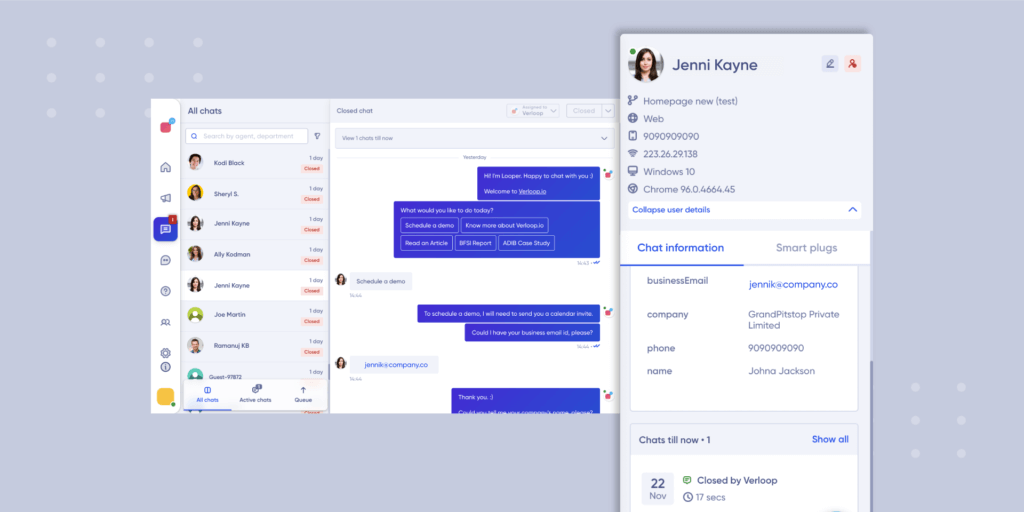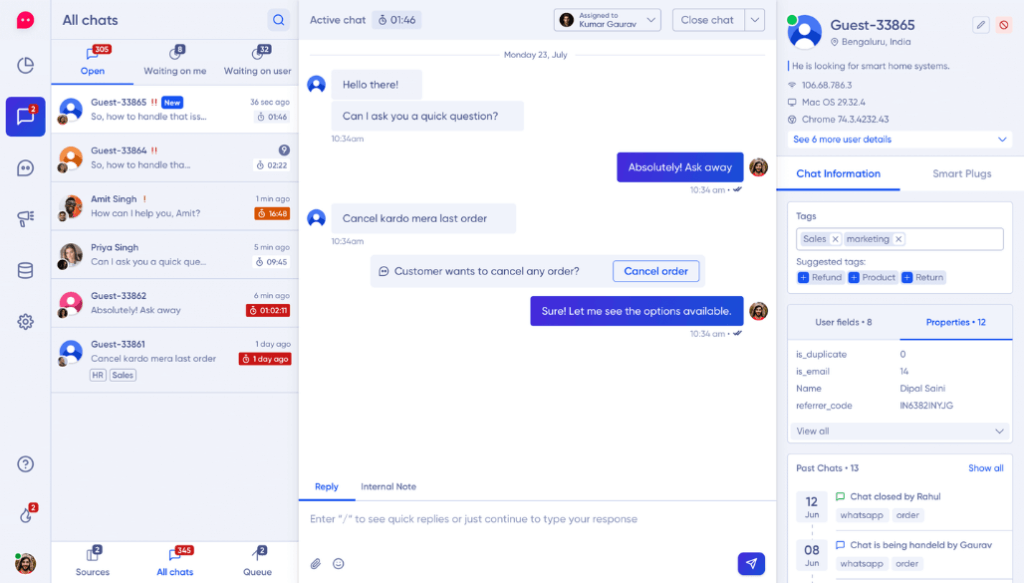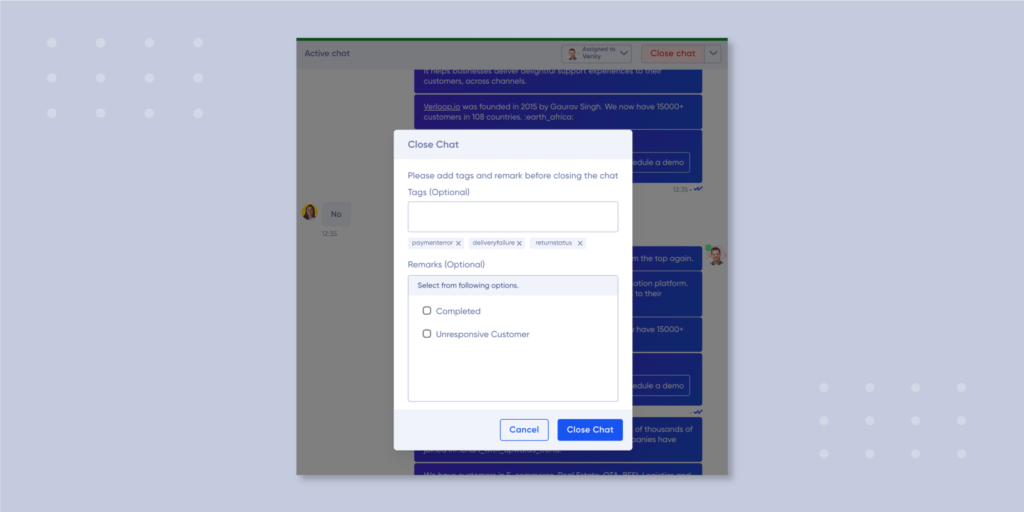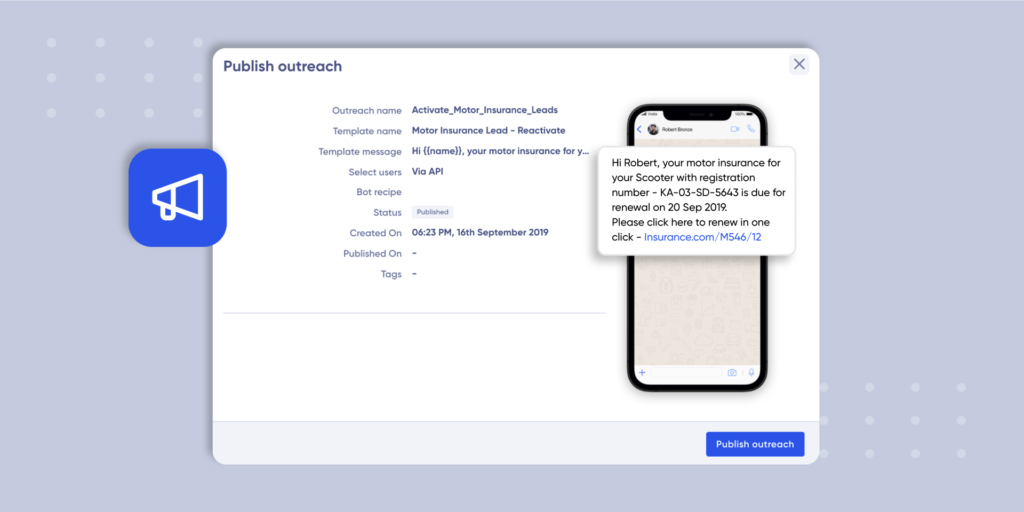Understanding Building Unified Customer Profile
- July 8th, 2025 / 5 Mins read
-
 Aarti Nair
Aarti Nair

Understanding Building Unified Customer Profile
- July 8th, 2025 / 5 Mins read
-
 Aarti Nair
Aarti Nair
A unified customer profile view is a holistic view of customers’ information. Let’s look at how brands can leverage it to create engaging CX, add personalisation and improve CSAT.
Customer service is all about customers. Organisations that keep customers at the centre perform better than those that don’t.
Being customer-centric means knowing your customers better and keeping them engaged, smartly. Basically, getting a 360-degree view of customers. In customer support it includes understanding your customers to anticipate their needs and preferences, responding quicker and creating personalised responses at different points of the buying journey.
When done right, customer-centric actions can lead to meaningful experiences. For one, customers value personalisation from brands they interact with. Second, delightful and friction-less CX leads to trust and trust leads to loyalty. So in the long run, organisations that are customer-centric acquire and retain more customers.
But the question is how do you become customer-centric and build smarter engagement? The answer is: leveraging the Unified Customer Profile view.
What is a Customer Profile?
Let’s start with a simple question:
Can your business confidently say it knows each customer beyond their name and last transaction?
If the answer requires opening five different tools and pinging three different teams, you’re not alone.
A customer profile is the foundation of every customer-facing interaction. It’s a structured summary of key data points—such as purchase history, demographics, channel preferences, support tickets, feedback scores, and behavioural signals—that define an individual or account.
But more than just a database record, a customer profile is what enables your teams to personalise outreach, predict needs, and reduce friction across the customer journey.
Here’s a quick scenario to put it in perspective:
A customer reaches out via chat asking for an update on their service request. Your support team has no context because the last interaction was logged in a separate CRM. Meanwhile, marketing has queued up an upsell campaign for the same customer, completely unaware of the open issue. What does that look like to the customer? Disjointed, impersonal, and inefficient.
And it’s not just anecdotal. According to McKinsey, 71% of consumers expect companies to deliver personalised interactions, yet most businesses struggle to do this at scale due to fragmented data.
So while you may already have customer profiles in some form like in CRM records, ticket logs, email lists but the question is:
Are they unified? Are they current? And more importantly, are they actionable across every team?
In the following sections, we’ll look at what it means to move from scattered records to a Unified Customer Profile and why that shift is critical to driving growth, loyalty, and efficiency. But let’s first understand what are types of customer profiling are.
What are the Types of Customer Profiling?
Let’s say your support team knows a customer prefers chat over email. Your marketing team knows they usually respond to discounts, and your product team has flagged them as a power user.
All valuable insights—but from very different angles.
This is where customer profiling types come into play. Businesses build profiles through various lenses, each offering a piece of the puzzle. The more types you layer, the clearer your customer becomes.
Here are the four core types of customer profiling commonly used in businesses:
1. Demographic Profiling
This is the most basic layer. It includes age, gender, income level, location, education, etc., especially useful for B2C and D2C segments.
In B2B, it often translates to firmographic data: company size, industry, location, and revenue.
For example, if you’re selling HR software, your pitch to a 500-employee company in India will differ vastly from one with 5,000 employees in the US.
2. Behavioural Profiling
This tracks how a customer interacts with your brand, like website visits, clicks, product usage, repeat purchases, and churn risk.
Why it matters: A customer who visits your pricing page three times in a week is likely more sales-ready than someone reading blogs.
And it shows in the numbers, according to HubSpot, companies using behavioural targeting see 2X higher conversion rates.
3. Psychographic Profiling
This digs into the why behind behaviours like values, interests, decision-making styles, and pain points.
In B2B, this helps you identify stakeholders who are innovation-driven versus those who are risk-averse or cost-conscious.
For a CX automation platform, one decision-maker may prioritise reducing ticket load, while another focuses on improving CSAT. Tailoring your pitch accordingly increases your win rate.
4. Transactional Profiling
This includes data like purchase frequency, average order value, payment methods, support issues, subscription plans, and returns.
It’s key for upsell, cross-sell, and retention strategies. An e-commerce seller identifies customers who abandon carts after browsing premium products. The sales team follows up with a limited-time offer. Conversions jump 18%.
Each profiling type on its own offers value. But the real power?
When you unify them across departments and platforms to create a complete customer view.
That brings us to the next and arguably most important—concept:
What is a Unified Customer Profile, and how is it different from traditional profiling?
What is unified customer profile view?
A unified customer profile view is a comprehensive view of customers’ data. In this profile, you can see customers’ basic information such as name, email ID, phone number, location, etc., their past purchase orders, previous chat or call history, etc. In short, everything about a customer since they first started interacting with your business.

A unified customer profile view is made of their past, present and future interactions.
- Past: a digestible view of customers’ history – their previous interactions and purchase history.
- Present: current data on customers, where they are chatting/calling from, context of the query, previous agent’s notes (if handover to multiple agents), etc.
- Future: information on customer’s behaviour. If there is an upsell or cross-sell opportunity, if the customer is likely to churn, etc.
A unified customer profile view is all about pulling pieces of information on the customer from different places and stitching them together to get relevant and specific information that can be used to deliver delightful experiences. That is, bringing all your customer data under one roof.
Businesses can build unified customer profile view by integrating their conversational platform with their:
- CRM and ticketing tools: Zendesk, Freshdesk, HubSpot, Mailchimp;
- Marketing software: Clevertap, Webengage,
- Payment channels: Razorpay, CCAvenue;
- Messaging channels: WhatsApp, Facebook Messenger, Instagram, Viber;
- Other apps: Shopify, Magento, Zapier, etc.
Because of these integrations, the customer profile is updated automatically after every interaction your business has with a customer.
How is a Unified Customer Profile Different from Traditional Profiling?
Most businesses think they know their customers. After all, there’s a CRM in place, a ticketing system for support, analytics dashboards for product usage, and a marketing automation tool that tracks engagement.
But here’s the catch: each of these systems paints a different version of the customer. And they rarely talk to each other.
This is traditional profiling where data stored in silos, often outdated, and only accessible to specific teams. It’s like each department sees a fragment of the customer through its own lens, never the full picture.
Let’s break it down with a real-world example:
A returning customer raises a support ticket for a failed payment. Your support team sees the issue in Zendesk, but not that the same customer is also running a high-value campaign with your product. Marketing continues to send nurture emails, unaware the customer is frustrated. Sales has no idea a renewal is at risk.
Now contrast that with a Unified Customer Profile (UCP).
A UCP consolidates all customer data, across tools, touchpoints, and teams into a single, actionable view. It includes identity data, behaviour data, interaction history, preferences, and predictive insights, all in one place.
So in the same scenario:
Your support agent sees the ticket, the customer’s product usage, recent marketing interactions, and their value tier. Instead of just fixing the issue, the agent prioritises the ticket, adds context, and flags the account to the success team for a proactive retention effort.
The difference?
Traditional profiling tells you what happened. Unified profiling tells you what matters and what to do next.
| Traditional Customer Profiling | Unified Customer Profile (UCP) |
|---|---|
| Data scattered across multiple platforms | Data consolidated into one unified platform |
| Team-specific access and use cases | Cross-functional access for sales, support, CX |
| Reactive insights | Predictive and real-time insights |
| Manual updates and syncs | Automated, live data syncing |
| No personalisation at scale | Hyper-personalisation across touchpoints |
According to Experian, 91% of companies with strong data unification see improved customer satisfaction. That’s not a marginal gain—it’s a strategic advantage.
So ask yourself:
- Are your teams making decisions based on fragments?
- Are they working from a single source of truth?
In the next section, let’s explore why Unified Customer Profiles matter and not just for customer experience, but for business outcomes.
Why is unified customer profile important?
Customer data provides context to interactions and reduces gaps in communication.
By leveraging data on customers, businesses can create smart engagement strategies and enhance customer experience.
Over the course of time, this data grows. And thanks to the wealth of data available on customers, businesses can provide a unified customer experience across channels and touchpoints.
A comprehensive customer profile equips businesses to create more engaging customer experiences, run relevant and targeted outreach campaigns and improve customer satisfaction. The five biggest benefits your businesses can see are:
- Deliver quick response
- Add personalisation
- Enhance AI’s performance
- Facilitate cross department communication
- Send relevant outreach campaigns
1. Deliver quick response
Customers want speedy responses to their queries. A HubSpot research shows that 90% of customers say an immediate response is an important factor when they seek support. 60% of these customers defined “immediate” as less than 10 mins.
With the help of a unified customer profile view, support agents get context on customer conversations and can respond quicker. They don’t have to toggle between tools to fetch data.

A 360-degree customer profile solves another problem. A Forrester research found that 42% of agents couldn’t efficiently solve customer queries due to a lack of customer information. Comprehensive customer data provides agents with information that helps them make quick decisions and resolve customer queries efficiently.
Ultimately, comprehensive customer profiles enhance agent and customer experiences at the same time.
2. Add personalisation
Customers want personalisation. A Salesforce Research showed that 63% of consumers expect B2C businesses to know their needs and expectations. For B2B, this number is 76%. According to another report (Accenture), 91% of customers are more likely to shop with brands that offer them relevant recommendations.
A unified customer profile view is the foundation for personalisation.
A holistic customer view gives a company a complete picture of customers’ purchase history, pages they visited on the website, previous chat conversations, channels on which conversations took place, etc. Based on this data, you can personalise your automated interactions with them, providing relevant information at the right time, right place.
3. Enhance AI’s performance
Analysing historic data provides us with information that positions us to see patterns and prepares us to make better decisions in the future. This is amplified for an AI.
An integrated customer profile allows AI to predict customers’ behaviour and their future needs. Finding patterns in data helps businesses resolve issues before they arise. Data on customers also help AI train itself and respond to customers accurately.
With this data-driven approach, businesses can use conversational AI to customer experience up to one notch.
4. Facilitate cross department communication
A customer moves through the marketing, sales and support departments depending on their stage in buying journey. Most of the time, there is a gap in transferring information from one team to another. Data loss can also happen when customers move from one channel to another.
A unified customer profile aligns sales, marketing and support teams, across channels.
By sharing a 360-degree view of customers means all departments are on the same page and the relevant information is passed on seamlessly. In other words, unified customer profile views eliminate silos and fragmentation of data.

Sales and marketing departments can use this data for upselling and cross-selling opportunities. Support representatives can view information from sales and marketing to understand their journey. A win-win situation for everyone involved.
5. Send relevant outreach campaigns
Outreach campaigns work best when they are sent to targeted audiences. With a unified customer profile, you can create better audience segmentation and hence, create more strategic campaigns.
Based on customers’ behaviour you can send them alerts, notifications, updates, reminders, invites, etc. With relevant information, customers feel more valued and loyal to your brand.

Outreach campaigns are important for businesses as they keep customer engagement active. With detailed customer profiles and targeted campaigns, businesses can increase customer interaction, get more responses from them and see higher conversion rates.
How to Build a Unified Customer Profile?
Building a UCP isn’t about adding another tool to your stack. It’s about making your existing systems work together seamlessly, in real-time, and across functions.
So where do you begin?
1. Start with Identity Resolution
Before you unify anything, you need to know who’s who. That means stitching together customer data from different systems like CRM, website analytics, chatbots, helpdesk tools, even billing software and mapping them to a single customer ID.
Tools like Salesforce, HubSpot, or Segment can help you match data points like email, phone number, or device ID to resolve identities across platforms.
2. Integrate Data Across Touchpoints
Your customer interacts with you in more places than you can think like live chat, WhatsApp, email, support tickets, product usage dashboards, and more. Each interaction creates a valuable data point.
The key is to connect all of these so that no touchpoint exists in isolation.
For instance, using Verloop.io’s Unified Chat Dashboard, your agents can view:
-
All past bot-led conversations
-
Human agent interactions across sessions
-
A Gen AI-powered summary (AI Summary) that gives agents the full context—without having to scroll endlessly
This isn’t just data aggregation but it’s data in context, ready to be acted upon.
3. Enrich with Behavioural and Transactional Data
A profile is more than static fields. To make it truly actionable, enrich it with:
-
Product usage behaviour
-
Recent purchases
-
Support ticket history
-
Campaign interactions
-
CSAT/NPS feedback
Pull this from your CDP, analytics platforms, support tools (like Zendesk or Freshdesk), and chat automation platforms like Verloop.io to create a real-time, evolving profile.
4. Enable Cross-Functional Access
A Unified Customer Profile shouldn’t live in a siloed dashboard. It should be available contextually and to anyone who interacts with the customer:
- Sales,
- Support,
- Success,
- Marketing.
This means embedding the profile into your:
-
CRM for sales (e.g. Zoho, Pipedrive)
-
Live chat or support console for agents (like Verloop.io)
-
Marketing automation tools for campaign targeting
-
Account management platforms for renewals and upsells
5. Leverage AI for Real-Time Insights
With data unified, the next step is to extract intelligence from it. Gen AI tools now offer smart summaries, next-best actions, tone detection, and even customer intent analysis.
With Verloop.io’s AI Summary, for instance, support agents can access an auto-generated overview of a customer’s entire conversation history summarised in seconds. This means faster resolutions, less manual reading, and more contextual responses.
So to recap:
A Unified Customer Profile isn’t built in one step. It’s stitched together, refined, and made actionable using the right tools, integrations, and intelligence.
And when done right?
It’s not just a better customer experience.
It’s faster resolutions, smarter conversations, and stronger lifetime value.
Leverage the Power of Unified Customer profile
Businesses are competing over customer experiences and meeting customer expectations. You need to provide personalisation and relevant content to create authentic and humanised connections.
A unified customer profile view can improve your interactions with customers and deliver better experiences at different points in the customer journey. This has a direct impact on customer satisfaction and retention.
Verloop.io is a leading conversational AI provider for customer support. We integrate with 100+ tools to provide a unified customer profile view that facilitates better communication, quick responses, personalised messages and targeted campaigns. To see how it works, talk to our team.

Frequently Asked Questions (FAQs)
1. What is a Unified Customer Profile (UCP)?
A Unified Customer Profile is a centralised view of a customer that consolidates data from various touchpoints—CRM, support tools, chatbots, marketing platforms, and more, all into one accessible profile. It helps teams personalise interactions, reduce friction, and improve decision-making.
2. How is it different from traditional customer profiles?
Traditional profiles are often siloed—sales sees one version of the customer, support sees another. A UCP brings all of this together into a single, consistent view, enriched with real-time behavioural, transactional, and interaction data.
3. What tools do I need to build a Unified Customer Profile?
You’ll need tools that can sync and integrate across systems. This usually includes a CRM (like Salesforce or Zoho), a CDP (like Segment), customer support platforms (like Zendesk or Verloop.io), and analytics tools. Platforms like Verloop.io also offer Unified Chat Dashboards and AI summaries to centralise support data and conversation insights.
4. Can smaller businesses benefit from Unified Customer Profiles?
Absolutely. Even smaller teams struggle with data fragmentation especially when dealing with support tickets, marketing campaigns, and sales outreach across different tools. A UCP helps create consistency, reduces duplication, and improves efficiency.
5. Is it difficult to implement a Unified Customer Profile system?
Implementation can vary based on your tech stack. However, many modern tools offer APIs, integrations, and low-code options to streamline the process. Platforms like Verloop.io can automatically unify bot and agent conversations, reducing setup complexity for support teams.
6. How does a Unified Customer Profile improve support operations?
It enables support agents to see the full picture through previous chats, open tickets, sentiment, purchase history—all in one place. This means faster resolutions, less customer frustration, and more context-driven conversations.
7. Can a Unified Customer Profile help with personalisation in marketing?
Yes. With access to behavioural data and preferences, marketing teams can create highly targeted campaigns—based on real interactions, not assumptions. This leads to higher engagement and conversion rates.






